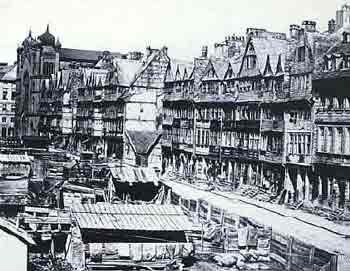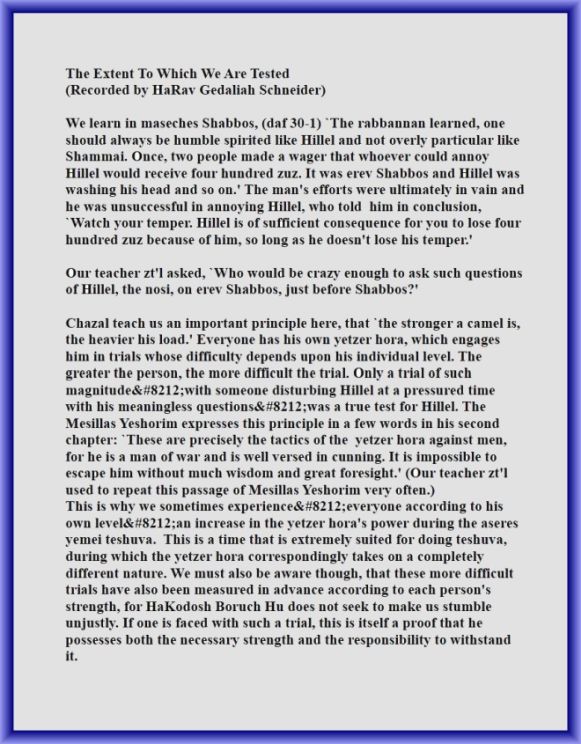Part of the Jewish area of Frankfurt in 1890

The Storm Clouds Gather
The yeshiva suffered continual ups and downs once the Nazis gained power in 1933. Foreigners were no longer permitted to enter the country. Funds were much harder to come by. Many of the students left the yeshiva in efforts to escape the volatile atmosphere of the country. Rav Schneider himself suffered extreme poverty.
But even in those reduced circumstances he didn't abandon his lifelong goal of educating to Torah. When bochurim from Poland could no longer come, he went to a local orphanage and began to teach the boys beginning gemora.
He sought out boys from a German background who were willing to come and study after a day's work. Twenty boys were drawn to join his yeshiva. They came early in the morning on bicycles with their morning bread in their pocket to daven shacharis and learn Torah until they had to go to work. They returned in the evening to resume their study, and only afterwards went home. On Shabbos and Sunday, they spent the entire day learning Torah.
This period didn't last long. When persecution increased under the Nazis, and Jews were thrown out of public (non-Jewish) schools, Rav Schneider was provided with another opportunity for full-time Torah teaching — and this time to youths who lived in Germany. He found twelve boys who had just finished school and were willing to sit and learn all day.
Many youths were joining different Hachshara programs as part of a plan to emigrate to Israel, and most such programs required a certain amount of time spent studying in yeshiva. Although most of the boys attended the other two yeshivos in Frankfurt, some parents, recognizing the intensity of Rav Schneider's yeshiva, preferred to send their children there. Others went to his yeshiva because they had no funds to pay tuition, and his yeshiva was the only one which didn't require tuition.

Reviving Rav Chiya's Methods
A number of these boys had come straight from public school, and were lacking basic knowledge of Judaism. Rav Schneider was undeterred. Everyone, at whatever level he was, was accepted.
Undeterred that many of these youths came for only half a year or a year, Rav Schneider set to work imbuing them with a love for Torah, basic skills in Torah study, and the right hashkofas. Because of the pressure of time, the work had to be done very quickly.
Rav Schneider introduced a new concept in gemora learning to accomplish this: The youths who had more experience in gemora learning were drafted to teach gemora and Tosafos to the newcomers for a month. Afterwards, the new boys had to prepare the shiur by themselves. If they didn't know the meaning of a word, they asked. Since it was unpleasant to keep asking, they made sure to learn each word well.
Barely a year later, these bochurim were already instructing a new group of bochurim who had joined the yeshiva, besides engaging in intense study themselves, a result of the enthusiasm and brenn that Rav Schneider had imbued them with. It was a reincarnation of Rav Chiya's tried and true method to revive Torah study when it was almost lost. It was a method which aimed to produce twenty roshei yeshivos instead of twenty bnei Torah.
During these difficult days, Rav Schneider carried an incredible burden. Besides giving two or three shiurim on different levels, he also gave mussar shmuessim and carried the burden of fundraising. Not only that, but every week he examined each bochur on the gemora and Tosafos that he learned, and Rashi on the parshas hashavua.
Once, a rumor spread that some bochurim in the yeshiva were wasting their time, engaging in idle activities. When the rumor reached Rav Schneider's ears, he immediately tested each of his students, and then invited the dayanim and rabbonim of the kehilla to examine the bochurim themselves.
Everyone had to admit that these young German youths knew gemora on a level that had been unknown in Germany for some hundred years. In a time of great tribulations, when every capable youth was busy thinking of ways to acquire a certificate with which to emigrate, Rav Schneider succeeded in creating an island of ahavas Torah in the spirit of the great Litvishe yeshivos. A number of the boys who came for only a year stayed on for a few years despite parental opposition.
A talmid: When I was 16, my family pressed me to leave yeshiva and join an agricultural training camp in preparation to immigrate to Eretz Yisroel. I spent a summer there, when before Rosh Hashanah, I received a fearful letter of mussar from Rav Schneider. He rebuked me, "Look at what you could accomplish if you would remain in Torah study!"
The letter had a strong impact on me, particularly the fact that the Rebbe hadn't pushed me away because of my deed. I wrote him that I wished to return, but on condition that he wouldn't mention my deed in public or private. He promised me this, and I returned to yeshiva.
As the situation for Jews in Germany deteriorated, Rav Schneider was offered a visa with which he could leave the country as well as a considerable sum of money to help pay for costs. However, he felt that it was his responsibility to stay and continue disseminating Torah during this daunting period.
A Closure Injunction
The government issued an order to close all rabbinical institutions. This vicious order sent all three of Frankfurt's yeshivos into disarray, with each trying to find a way to avoid the gezeira and to keep its own doors open.
Rav Schneider knew that, as a foreigner, the decree was directed against him more than against the others, and that his chances were slim to be able to get out of it. He approached the directors of the other two yeshivos and asked to officially join them as a branch of their yeshiva. The worried directors would not countenance his plaintive request, fearing that it would guarantee repercussions. "The authorities are not blind," they insisted. "We cannot afford to do anything that will allow them to think we are deceiving them."
With no way out, Rav Schneider employed his usual means of action—vayitz'aku el Hashem—he and his bochurim cried out to Hashem with heartfelt tears and supplications. After this effective form of hishtadlus, he decided to try an apparently worthless form of hishtadlus: he wrote a letter to the government official who had issued the decree, begging him to rescind it in his case.
"I've spent all the years of my life running this institution! Please have mercy on me and let me continue! Do not throw me out in the street!"
Anyone would have said that it was hopeless to think that this hardhearted official would be moved by this plea.
Miraculously, though, the official granted him a permit to keep his yeshiva going. When the other yeshivos approached the official to request a permit, they were brushed aside. "I already gave a permit to one yeshiva in Frankfurt—that's more than enough!"
To their chagrin, the directors of these yeshivos had to approach Rav Schneider and ask if he would agree to consider them to be a branch of his yeshiva. In the end, these directors submitted a special petition to the official, "If you are giving a permit to a foreigner who came to Germany for just a short time, how much more you owe it to those kehillos that have existed in Germany for many generations!"
In the end, inexplicably, the decree was rescinded by the very official who had instituted it. The salvation came from the very institution that, in everyone's eyes, was in the most hopeless situation of all.
At one point, the government forbade minyanim to remain open. A number of minyanim closed, but of course, things went on as usual at Rav Schneider's. When the Gestapo heard a rumor that Schneider's yeshiva was breaking the law, they sent some men to investigate.
The minute they knocked on the door, the minyan had just started Shemoneh Esrei, and only the non-Jewish maid was around to answer. "No, there are no prayer sessions going on here," she declared innocently. They accepted her assertion and left. A second later, the minyan started chazaras hashatz.
Once, the Gestapo made a frantic attack against shuls in Frankfurt, in which hundreds of seforim were viciously attacked and ripped. The seforim lay strewn all over the street, with some pages fluttering in the air and others dragged in the gutter.
Late at night, Rav Schneider sent his daughters out to collect whatever was possible to be reconstructed. Although many of these seforim were Sheilos Uteshuvos and kinds of seforim that he was not wont to study, those seforim, with their torn covers, were fixed and they held a respected place in his library until the end of his life.
Rav Grunfeld, of London: I was there when a group of hooligans broke into the yeshiva holding weapons, and they injured a few of the bochurim. It was just before shacharis, and Rav Schneider was wrapped in tallis and tefillin, when he heard the noise and entered the room.
He cried out, "Ribono shel olam! To where have we come? It is written that `all the nations of the world will see that the name of Hashem is called on you, and they will fear you'—and Chazal explain that this refers to the head tefillin. Is it not so by us?"
When the hooligans eyes beheld his majestic appearance, they stopped their cruelty and fled.
End of Part 3




